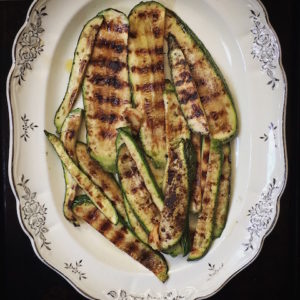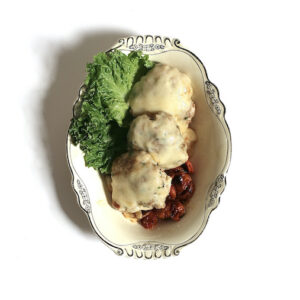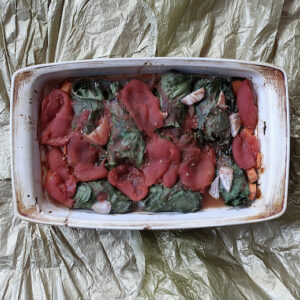Chicken Tikka Masala
We’ve been lagging in the post department round here. Sorry about that. The holidays, the news, all the usual reasons a blog goes dark. Never mind. It’s 2017. We’re back, bearing news of Chicken Tikka Masala.

(A fair copy of a shot the IK took with her cell phone. This one taken with her real camera. Fun with filters and garam masala.)
Granted, if you are a reader in the British Isles–and thank you, by the way–Chicken Tikka is no news at all. Here in America, however, Chicken Tikka Masala is not a national passion. Americans do not understand, to employ an English term, Chicken Tikka’s addictive moreishness. Chicken Tikka Masala is so very moreish, in fact, that should any be leftover, the IK will eat it, cold, until it’s gone. She is unashamed of her addiction, because upon consulting her many, many British cookbooks, she found countless iterations of Chicken Tikka Masala and its Anglo-Indian-curry offshoots. This led her to realize she was far from alone in wolfing chilly spoonfuls of creamy, tomatoey rice long after dinnertime.

The IK’s initiation into all things CTM occurred thanks to her other life as a book reviewer for Popmatters.com. Here she reviewed The British Table: A New Look At The Traditional Cooking Of England, Scotland, And Wales by Coleman Andrews. This is largely a wonderful book, what with Coleman Andrews being himself, and the photographs being shot by Christopher Hirsheimer and Melissa Hamilton.
The major trouble arises when one attempts to cook from said book: the recipes are poorly copyedited, if at all. Andrews is blameless in this–an author of his stature certainly knows how to write a recipe–but the book is rife with mistakes. Given this, I still strongly recommendThe British Table. Do proceed carefully before cooking anything, though, reading each recipe through, making notes of errors, perhaps even making a clean copy if necessary.

Some prep notes. While Chicken Tikka Masala isn’t a set it and forget it, neither is it difficult; having made it, oh, seventeen times in the past two weeks (cough), I promise you the dish requires attention but no skill. Nor is any fancy equipment needed, a good thing since many of us lack our food processors just now. You’ll dirty a spatula and spoon, but there’s time to clean up mid-recipe.
The recipe calls for downmarket ingredients certain to get up the noses of snobby types like yours truly. Canned soup? Boneless skinless chicken breasts? Omigod! Look, just make the recipe. You’ll thank Coleman Andrews later.
Successful tinkering with this recipe includes replacing the lime juice with lemon–that includes unripe lemon, for you Californians with lemon trees, and substituting half-and-half for the heavy cream, simply because I keep half-and-half in the house for coffee.

The recipe calls for chili powder, which I don’t have; I used red pepper flakes. Which brings us to chicken tikka’s heat level: this is a creamy dish, which counters the spiciness. Nevertheless, the heat gradually creeps up on you as you shovel it into your face. I’d call it moderate. Still, if spice isn’t your thing, decrease the initial marinade spices to a quarter teaspoon each, and the final tablespoons even more–while this is your call, chicken tikka masala is meant to be somewhat punchy. If spicy food isn’t your thing, this may not be the recipe for you.

A final note about the Campbell’s Tomato Soup: the original recipe calls for 8 ounces. Here in the United States, Campbell’s Soup is sold in 10 3/4 ounce cans. Having no use for 1 3/4 ounces of leftover soup, I used the entire can in the recipe and it worked just fine. While we could be uppity, using a higher-end tomato sauce, the end result is so insanely delicious I see no reason to get snooty. Why mess with perfection?

Chicken Tikka Masala
adapted from The British Table by Colman Andrews
yield: 2-3 servings (or enough for 1 greedy person)
Chicken needs minimum 1 hour marination time and about one hour cooking time
For the marinade:
2 pounds boneless, skinless chicken breasts (ideally organic)
juice of one lime (see notes)
1/2 cup plain, full-fat yogurt
1/2 teaspoon ground cumin
1/2 teaspoon ground ginger
1/2 teaspoon ground turmeric
1/2 teaspoon ground cayenne
2 teaspoons salt
1 tablespoon neutral oil (canola, peanut, or sunflower)
To prepare the Chicken Tikka Masala:
2 tablespoons vegetable oil, for browning the chicken (use same as above)
1 onion, peeled and finely chopped
2 cloves garlic, peeled and minced
1 can Campbell’s tomato soup
1/2 cup heavy cream
1 tablespoon tomato paste
1 teaspoon chili powder
1 tablespoon curry powder
You will need a large bowl, two spatulas (one for deglazing, another for scraping yogurt marinade), tongs, a regular dinner plate or pasta bowl, and a large lidded frying pan.
Make the marinade:
In a large bowl–I use a 4-quart Pyrex–mix the lime juice, yogurt, cumin, ginger, turmeric, cayenne, salt, and tablespoon of oil. Add the chicken breasts and coat them thoroughly. I find my hands are best for this. Cover bowl with plastic wrap or foil. Refrigerate at least one hour and up to four.
While chicken marinates, chop onion and mince the garlic.
I also open the soup and pour it into a 2-cup measure, adding the 1/2 cup of heavy cream, the tomato paste, chili and curry powders. Blend with fork or whisk: it will be a pretty salmon pink (see photo in post). Save the soup can for the next step in recipe. This saves washing up.
If you are making rice with your chicken tikka masala, start it now.
To cook:
Place a 10-12 inch frying pan over medium high heat. Add about 2 tablespoons oil. Remove chicken from yogurt marinade with tongs, allowing excess to drip into bowl. Reserve marinade.
Brown chicken about 6 minutes per side, turning once. You are just getting some color on the chicken, not cooking it through. Do this in batches if necessary, adding a bit more oil if necessary (I’ve never needed to). Remove chicken to the dish and allow to cool.
Returning to your empty soup can: add enough water to fill it about 1/4-1/2 full, but no more. Pour this into the frying pan, crank up the heat, and deglaze, scraping up any baked on bits with a spatula. After about one minute, turn heat down to medium and pour in the remaining yogurt marinade, scraping out whatever is left with a spatula.
Cook marinade down, stirring, about one minute. Do not allow yogurt to boil rapidly; you want no more than a gentle simmer.
Add the onion and garlic. Cook 6-8 minutes, stirring occasionally. Watch the heat, turning down if necessary: you want the aromatics to soften, not brown. Add a little oil if the pan goes dry.
If you haven’t blended the tomato soup, cream, tomato paste, curry and chili powders, do so now. Pour slowly into pan to avoid spattering. Stir to combine, turn heat down a bit, cover pan, and allow to cook for ten minutes. This is a good time to clean up and…
Slice the chicken breasts into bite-sized pieces. After ten minutes, return chicken to the pot to finish cooking. Cover the pan, or not, allowing everything to heat through. This takes 5-10 minutes.
Chicken Tikka Masala is best eaten in bowls, classically served over white rice.
Serve the rice, then add the Chicken Tikka Masala. If you are virtuous, add something green. We are not. We just dive in. Major Grey’s Chutney is traditional; we’ve yet to try it, but that’s a matter of time.
Notes: Lemon juice works if you have no lime. Half-and-half works in place of heavy cream. Please don’t use low-fat yogurt, which can affect texture. I did not have chili powder, so replaced it with red pepper flakes.
Chicken Tikka Masala keeps very well, refrigerated, for the 12 hours I have managed to keep it in the house. Does it keep beyond then? I couldn’t tell you, because it never lasts that long.





